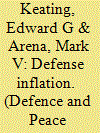| Srl | Item |
| 1 |
ID:
144152


|
|
|
|
|
| Summary/Abstract |
US Department of Defense (DoD) procurement and maintenance costs have risen considerably faster than economy-wide inflation over the last several decades. This outcome has occurred in large part because DoD decision-makers have demanded more complex, better maintained systems over time. Defense inflation is likely to abate when resourcing levels no longer accommodate these demands. Defense inflation should be viewed partially as a symptom, not just as a cause, of increased defense spending.
|
|
|
|
|
|
|
|
|
|
|
|
|
|
|
|
| 2 |
ID:
144155


|
|
|
|
|
| Summary/Abstract |
This paper describes recent research on cost indexes by the Institute for Defense Analyses. It was performed at the request of the Cost Assessment and Program Evaluation directorate in the Office of the Secretary of Defense to assist in meeting the requirement in the 2009 Weapon Systems Acquisition Reform Act to assess and update the cost deflators the Defense Department uses to adjust for price growth in costing and budgeting major systems. The paper’s focus is on aircraft procurement. The research analyzes deflator algorithms and data to determine the source of the wide differences in aircraft cost growth rates calculated by (a) the Gross Domestic Product deflator for the entire US market basket of goods and services, (b) the national defense index for military aircraft published by the Bureau of Economic Analysis, and (c) the Producer Price Index for civilian aircraft published by the Bureau of Labor Statistics. The study demonstrates an alternative hedonic approach for calculating price indexes by using regression analysis to relate aircraft investment cost to the aircraft’s specific physical and operational design features such as weight and speed.
|
|
|
|
|
|
|
|
|
|
|
|
|
|
|
|
| 3 |
ID:
166740


|
|
|
|
|
| Summary/Abstract |
Operating costs per unit of input or output are often claimed to grow faster in defence than elsewhere in the economy. In this paper, we outline several possible reasons as to why operating costs increase at higher rates in defence, including differences in the input factor mix and productivity growth, the technological complexity required to maintain the relative effect of weapon systems and a gradual reduction in the number of units and activity. We investigate whether operating costs grow at a faster rate than elsewhere in the economy, by estimating growth in real output unit costs in the Norwegian Armed Forces for the period 1994–2013, using activity as a measure of output. We find no increase beyond general inflation in structural (fixed) costs, whereas activity-based (variable) costs per unit of activity increase significantly.
|
|
|
|
|
|
|
|
|
|
|
|
|
|
|
|
| 4 |
ID:
076427


|
|
|
|
|
| Publication |
2007.
|
| Summary/Abstract |
This paper, intended to stimulate debate, suggests that we are at a turning point in the history of the UK military aerospace industry. It argues that there is urgent need for a fresh vision as to how the UK military aerospace industry can both prosper and make its maximum contribution to the defence of Britain. Further, the resulting plans and policies must emphasise the robustness of defence capabilities in a future in which the only thing we can be certain is that it will be very different from the present - especially whenever defence most matters.
|
|
|
|
|
|
|
|
|
|
|
|
|
|
|
|